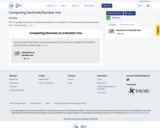
This is a google slides lesson comparing decimals on a number line. Students first locate the decimals, then compare using <, >, or =.
- Subject:
- Mathematics
- Material Type:
- Activity/Lab
- Author:
- Elsie Owens
- Date Added:
- 05/18/2021

This is a google slides lesson comparing decimals on a number line. Students first locate the decimals, then compare using <, >, or =.

In the first unit of Grade 5, students will build on their understanding of the structure of the place value system from Grade 4 (MP.7) by extending that understanding to decimals. By the end of the unit, students will have a deep understanding of the base-ten structure of our number system, as well as how to read, write, compare, and round those numbers.
In Grade 4, students developed the understanding that a digit in any place represents ten times as much as it represents in the place to its right (4.NBT.1). With this deepened understanding of the place value system, students read and wrote multi-digit whole numbers in various forms, compared them, and rounded them (4.NBT.2—3).
Thus, Unit 1 starts off with reinforcing some of this place value understanding of multi-digit whole numbers to 1 million, building up to that number by multiplying 10 by itself repeatedly. After this repeated multiplication, students are introduced to exponents to denote powers of 10. Then, students review the relationship in a whole number between a place value and the place to its left (4.NBT.1) and learn about the reciprocal relationship of a place value and the place to its right (5.NBT.1). Students also extend their work from Grade 4 on multiplying whole numbers by 10 to multiplying and dividing them by powers of 10 (5.NBT.2). After extensive practice with whole numbers, students then divide by 10 repeatedly to extend their place value system in the other direction, to decimals. They then apply these rules and perform these operations with powers of 10 to decimal numbers. Lastly, after deepening their understanding of the base-ten structure of our place value system, students read, write, compare, and round numbers in various forms (5.NBT.3—4).
As mentioned earlier, students will look for and make use of structure throughout the unit (MP.7). Students will also have an opportunity to look for and express regularity in repeated reasoning (MP.8), such as “when students explain patterns in the number of zeros of the product when multiplying a number by powers of 10 (5.NBT.2)” (PARCC Model Content Frameworks, p. 24).
This content represents the culmination of many years’ worth of work to deeply understand the structure of our place value system, starting all the way back in Kindergarten with the understanding of teen numbers as “10 ones and some ones” (K.NBT.1). Moving forward, students will rely on this knowledge later in the Grade 5 year to multiply and divide whole numbers (5.NBT.5—6) and perform all four operations with decimals (5.NBT.7). Students will also use their introduction to exponents to evaluate more complex expressions involving them (6.EE.1). Perhaps the most obvious future grade-level connection exists in Grade 8, when students will represent very large and very small numbers using scientific notation and perform operations on numbers written in scientific notation (8.EE.3—4). Thus, this unit represents an important conclusion to the underlying structure of our number system and opens the door to more complex mathematics with very large and very small numbers.